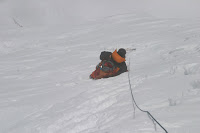
Two Utah Sherpas who are revisiting their old friend Mt. Everest have left base camp this week and embarked on the long, grueling trek for the summit.
Both men are part of a unique all-Sherpa team that is on its way across the Khumbu Icefall, not far above base camp, at the head of the Khumbu Glacier, according to Katie Eldridge, a spokeswoman for the expedition. The climbers must use ropes and metal ladders to cross the icefall, which is regarded as one of the most treacherous stages of the South Col route to the summit.
Large crevasses can open up with little warning, and climbers have fallen. Big blocks of ice sometimes tumble down the glacier and have crushed climbers in the past.
The two Utah Sherpas are intimate with the dangers they face when trying to summit the world's highest peak. Apa Sherpa has reached the top of the world a record 16 times. Lhakpa Gelu Sherpa holds the record for the fastest ascent.
Both Utah men, who come from part of a relatively small Sherpa community in Nepal (and therefore share the same last name), are keenly aware that people, many of them Sherpas who Apa and Lhapka sometimes know, die every year on Everest.
Just last week, on April 26, Dawa Sherpa, 40, died between camps 2 and 3 on the mountain. There are conflicting reports on exactly how he died.
On the Web site www.mounteverest.net, Dawa is called a "high-altitude worker" from Solokhumbu. He was part of a 10-member commercial team led by an Austrian climber.
Even less information is known about Dawa in a report on the Web site www.everestnews.com. A quote on the site reads, "Our thoughts and prayers go out to the Sherpa family." Dawa's death came just a few days before the Utah Sherpas arrived at base camp of the 29,035-foot peak.
What is upsetting to Utah mountaineer Roger Kehr is that there isn't more information published in the media about Dawa's family, including who he leaves behind.
"He's labeled the first death (of the climbing season on Everest), and that's the end of the story," Kehr said Tuesday in an interview.
After the interview, however, Kehr's wife was able to find out that Dawa was married with four children, the oldest being 10. His other job was in construction.
Kehr was, along with Utahn Jerry Mika, a co-manager of the base camp for Apa and Lhakpa's team. However, Kehr was unable to correct some irregular vital signs and was recently forced to return to Utah.

The team actually left Utah at the end of March, but it can take several days just to reach Everest's base camp in the Himalayas, and then more time is needed for most climbers to acclimatize at altitude, which for Everest's base camp is at 18,370 feet. As of Tuesday afternoon (they are 12 hours ahead of Utah in Nepal), Mika was still on the mountain.
The historic SuperSherpas Expedition is being filmed for a documentary on Sherpas, the unheralded heros of climbs that typically glorify rich clients of companies that hire Sherpas to carry heavy loads, paying them about $8 a day. Kehr said Sherpas receive very little, if any, recognition when the media reports on a Westerner who summits.
"People treat them like mules," Kehr said. "But how many mules can save your life?" They also set up tents for everyone, cook the food and "keep you from doing something stupid" on the mountain, Kehr added.
With the SuperSherpas Expedition, however, "it's payback time," Kehr said. This time, Westerners are the support team for Apa and Lhakpa. The documentary about the climb, he added, will focus on the Sherpas, their lives, the community they come from and the challenges they face there. The Sherpas hope the documentary will raise money for education and other services in Nepal and increase awareness about Sherpa culture.
So far this climbing season, two men from Kazakhstan, with help from Sherpas, have reached the summit of Everest. "Five Sherpas, who probably fixed ropes for them, summited, too — but you don't hear any of their names," Kehr said.
Exactly when — or if — the Super Sherpas team will make it to the summit is uncertain. As with any expedition on Everest, a lot will depend on what weather conditions are like in the coming days and weeks for Apa and Lhakpa's team.
by, Stephen Speckman, sspeckman@desnews.com












.jpg)





